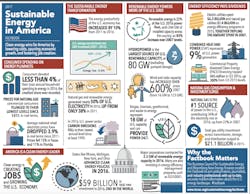The latest edition of the “Sustainable Energy in America Factbook” isn’t about microgrids per se, but it says a lot about the technologies commonly used inside microgrids.
Many of the technologies are thriving and prices are falling, particularly for energy storage and solar. Fuel cells are on an uptick too, according to the report released this week by the Business Council for Sustainable Energy and Bloomberg New Energy Finance.
Less encouraging, combined heat and power (CHP) use is slipping, and demand response faces future uncertainty.
Microgrids come in many shapes and forms, and they use a range of resources. But take the lid off an older microgrid, and you’ll likely find CHP and natural gas generators, especially for those microgrids that serve universities. Newer microgrids tend to also incorporate solar, demand response, fuel cells, and especially energy storage.
Microgrids are increasingly built to cut carbon and bolster clean energy – what the report calls the “the new normal” on the U.S. grid.
As clean energy use rises, electricity prices are falling. In fact, consumers now pay 3.9 percent less per kWh for electricity than they did in 2007, according to the report.
“The contributions of sustainable energy to the country’s economic competitiveness are direct, dramatic and dynamic,” said Lisa Jacobson, president of the Business Council for Sustainable Energy, a coalition of clean energy companies and trade associations based in Washington, D.C.
The low energy prices make the U.S. one of the most competitive places in the world for industry, better than China, India, Mexico and Japan, according to the report.
The report also found a steady rise in spending for distribution automation since 2008. Used to improve reliability, particularly as intermittent renewables come online, distribution automation helps make the grid more microgrid ready.
Here’s how the report positions several technologies found inside microgrids (and of course on the central grid) at the start of 2017.
As clean energy use rises, electricity prices are falling.
Energy storage market shift
The U.S. has the most dynamic energy storage market in the world – but it is changing. While government policy drove the energy storage market from 2009 to 2014, today the U.S. industry is developing its own business and financing models.
Energy storage projects also are on the rise, with PJM’s frequency regulation market leading the way. From 2015 into early 2016 the grid operator saw a rush of new energy storage, which now totals 280 MW.
California, the other big market, is seeing growth in energy storage, centered around a need for grid system capacity. In addition, 55 MW/220 MWh of energy storage was quickly delivered in 2016 to make up for expected gas shortages due to leaks at the Aliso Canyon gas storage facility.
The report also notes energy storage activity in Hawaii, Washington, New York and Massachusetts.
Lithium-ion batteries remain the technology of choice, but new battery composition is in the works, receiving some investment and securing a few commercial-scale contracts, said the report.
Sunverge won the most investment dollars for stationary storage in 2016, $36.5 million from the Australian utility AGL Energy, as well as from Siemens Venture Capital, Softbank China Venture Capital and Australian Renewable Energy Agency.
Aquion Energy, a saltwater battery manufacturer came in second with $33.2 million, followed by Eos Energy Storage, $23 million and ViZn Energy Systems, $16 million.
Energy storage is increasingly found inside microgrids paired with solar and other renewables.
Renewables and natural gas knock out coal
The U.S. is now generating more of its electricity from natural gas and renewables, a function of falling prices. Together they now meet half of US power demand, up from only 38 percent in 2011. In fact, natural surpassed coal in 2016 to become the largest single fuel source for U.S. electricity.
Together, renewables and natural gas provide half of US power.
For commercial customers, natural gas prices fell to their lowest levels since 1977 in real terms. Industrial prices sank to their lowest recorded levels ever. The report also found that it is now cheaper to build a new natural gas plant than to build a coal plant across most of the US.
Overall, solar installations rose 73 percent in 2016, with 12.5 GW added, the largest addition from any single technology for the year. Thanks to a drop in renewable energy prices and better equipment performance, large customers are now able to sign power purchase agreements at under $40/MWh. Given the price advantage, it’s not surprising that commercial and industrial solar installations rose 34 percent to 1.1 GW. Residential solar increased 14 percent to 2.3 GW.
Fuel cells climbing again
Use of fuel cell technology is climbing again following a slump after it reached an all-time high in 2012. Most of the activity is in California, Connecticut, Delaware, New York and North Carolina.
Projects noted by the report include FuelCell Energy’s 63.3 MW Beacon Falls Connecticut, being developed with O&G Industries and CT Energy & Technology. Beacon Falls is expected to be the largest fuel cell project in the US when completed.
Meanwhile, Bloom Energy announced a strategic alliance with PowerSecure to deploy 50 MW of Bloom’s fuel cells for commercial and industrial businesses, such as Home Depot.
The industry has seen a decline in venture capital investment since 2011. However, companies like FuelCell Energy and Bloom Energy appear to be using alternative forms of finance for growth, the report said.
Combined heat and power (CHP) slips
CHP has seen a drop in installations, following a peak in 2014 of 1,397 MW. Total U.S. CHP capacity fell from 82.7 GW to 81.1 GW, largely due to retirement of older plants and closure of industrial facilities that used CHP.
However, the report acknowledged that its figures may not represent smaller and newer CHP installations.
CHP contributes about nine percent of total US generation.
Natural gas remains the most popular fuel for CHP, used for 71 percent of installed capacity, according to the report.
Steam turbines, internal combustion engines and gas combustion turbines remain the cheapest to build for CHP. Meanwhile, the price range of microturbines has continued to tighten, the report said.
Demand response: Future in DER aggregation?
PJM uses the most demand response worldwide and represents 40 percent of US wholesale market. However, new rules in PJM are causing a decline in the three-year ahead auction.
Meanwhile, MISO tends to use demand response for emergency resources that are not directly dispatchable but operate through utility programs. In California, demand response provides a large share of real-time and day-ahead dispatchable capacity.
The Federal Energy Regulatory Commission’s 745 ruling has brought some stability to the demand response industry.
In addition, grid operators are increasingly looking at ways to aggregate distributed energy resources, including energy storage, so that they can provide demand response.
Credit: 2017 Sustainable Energy in America Factbook by BCSE and BNEF
Learn more about the technologies inside microgrids by subscribing to the free Microgrid Knowledge newsletter.







